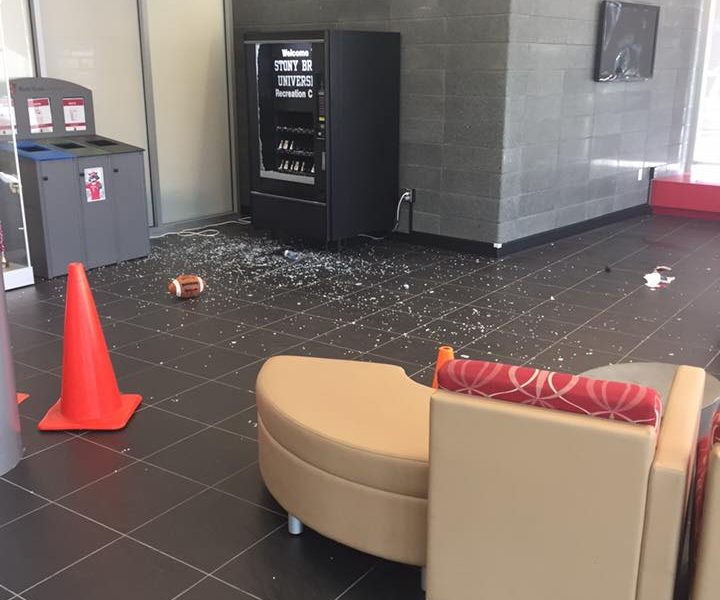As the infrastructure of the Union building slowly crumbled, the space the students occupied established a personality of its own. The club rooms became distinctive, unique and became in all but on paper, theirs.
By January 2016, those clubs will be losing that space. According to Howard Gunston, the Director of Facilities, Operations and Reservations, most clubs will be moved to the Student Activities Center (SAC). The Student media organizations are expecting to move into a new media wing in SAC 307, while the Union’s club alley will be moved to SAC 010A.
“The Union is old and decrepit,” said Lauren Fetter, the Executive Editor of the Stony Brook Independent. “I feel like everyone sees the union as the red-headed step-child, in a way—everyone knows it’s there, but no one really wants to interact with it until they have to.”
Space was also limited. Blackworld Magazine has been working in the same room as the Stony Brook Independent since last year and the confining space curbed some of their activities.
“Being in the Union has limited us from having consistent meetings do to the fact that we have to share space with the Independent. The space was very small and kind of killed our morale to have meetings” said Marshall Wayne Cooper. the executive chief editor of Blackworld.
But being old had it’s perks. Those clubs which have used the rooms for their Union activities have had enough time to leave a deep mark into the walls and atmosphere of their space.
Like that of short rows of bookshelves buckling under the weight of fantasy and science fiction novels, the dim lighting and the dark ambience of the Science Fiction Forum. The room models what club members like about their favorite mediums, the tone and mystery of unfathomed places.
While they watched their room fall apart, especially the old book shelves which buckle under the weight of the volumes, president of the Sci-Fi Forum Ted Gervais has fond memories of the Forum.
“The room and the building both have a lot of character, so I’d hate to see them go,” he said.
Everything to support the average student was under that old roof. Whether it was Starbucks, the Union Commons or the other delis, everything was available. So many clubs got used to living within such a closed environment, the space was akin to a greenhouse of student life.
“Some of the editors sleep on the couches, they eat in there,” said Bridget Downes, the assistant multimedia editor of The Statesman. “I like how roomy the space is. All the editors can be working at the same time.”
Members of clubs treated their rooms less as meeting spaces but more as second homes. In the basement, it became a comforting sight to see the skeleton holding a plate of condoms outside of the LGBTA’s club room while their voices and laughter drifted into the hall. Further down there was always the buzzing sound of a CRT television from the folks playing Super Smash Bros. in Animated Perspectives club room.
“I am really going to miss being able to relax in our club space at any point of the day as well as pretty late into the night,” said Justin Schaller, president of Animated Perspectives.
But for some, the gutting of the Union will mean a total destruction not only to their work and living space, but to their entire club.
The Craft Center currently understands that none of their materials such as their potter’s wheels or any of their crafting supplies will be moved to a new work space, and that when the Union’s renovations are done, there will be no space reserved for the craft center.
“I’m heartbroken,” said Craft Center member since 1991 Dale Krongel as she sat behind a potter’s wheel, her hands splattered with clay. “This was my therapy, this was my second home.”
“Its terrible for the kids,” said longtime member Joanne Coppola. She said that the craft center was an excellent form of therapy for the students, especially those stressed with the hard sciences and maths subjects.
“Everyone has issues in their lives. This was a great way to relieve the stress.”
In many ways, the transfer of clubs out of the Union is more than a simple change of scenery. It is an act of leaving behind a legacy. The Stony Brook Press was forced to move from their old quarters in the bottom of the Union Basement after administration found the room’s heater wasn’t working. For many Pressians, leaving that space was heartbreaking. The room had a history that was manifest from the graffiti strewn walls to the random knick knacks on shelves preserved like ancient relics to a forgotten culture. They were moved into one of the upstairs rooms, and now were made to move again.
The future is muddy, it is hard to tell at this point whether the new spaces allocated to clubs will fulfill their needs, but the most they can hope for is to keep the same culture and personality that has kept each new generation of students coming by, then never leaving.




Comments are closed.